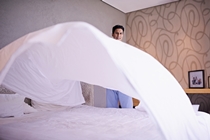AARP Hearing Center

I slide down in my wheelchair and sigh as I look at the crinkles in the bottom sheet of my bed, as I’m about to be helped into it for the night. I flashback to when I was ten or eleven – some seventy years ago – I was a city kid attending summer camp in the mountains of New England. We lived in a rustic (at least, that was our perception) cabin, in what was advertised as country, outdoors living. It was “roughing it” in a wooded paradise far different than our existence in New York City.
Eleven other boys would live in the bunk for the three months of summer. We each had a metal frame bed that our counselor showed us how to make properly - the Army way: sheets had better be tight, or there’d be hell to pay for the soldier. Things wouldn’t go well for us campers, either.
That may seem pretty regimented for fifth graders, but it was 1943 - war time. The inspecting counselor had better not see that our beds had been slept in the night before. It had to look “spick and span.” Like new. A virgin bed – except that word wasn’t said to us.
Fast forward seven decades. Now I’m a disabled resident in an Assisted Living Facility (ALF). I’m in a wheelchair and my hands don’t function properly. I need caregivers to make my bed.
Now-a-days bed making begins with the fitted sheet, which is a synonym for the bottom sheet. However, there was no fitted sheet back then; it wasn’t designed until 1959. That means the bottom sheet was flat. That also means to the inspector, the flat sheet had to appear as if the fitted sheet had been invented then. That meant tightly drawn and “hospital corners” on both head and foot ends. Hospital corners were also required for the top sheet and blanket. That was a lot of lifting and tucking for my narrow shoulders and tiny hands.
The singular sign that the bed was made properly was if a coin bounced on the bottom sheet when the inspector flipped it. We each held our breath and stared hard at the center of the mattress as the coin was tossed in the air slightly above the bottom sheet. Would it bounce? Or lie still? Was I finished making the bed or would it be stripped and have to be redone?
But even if the coin bounced, we weren’t in the clear: were pillows puffed? No sign that a head had rested there.
It was the camp’s intent that this independent, do-it-yourself household task follow us home. No more mother making our beds.
Well, here I am seventy years later, in a new millennium, yet, and I don’t make my own bed. Despite the rigorous training of my days at camp, the tense moments waiting for the coin to bounce, countless years sharing bed making with my wife, my bed is made for me by a caregiver. Oh, how I wish she was looking over my shoulder when I was a nervous camper staring at the bottom sheet. If so, my present bed would be made the proper-to-pass-camp-inspection way. Here, in the LF, I wouldn’t call it bed making. It’s more like mattress covering.
I shouldn’t complain, though. The way the caregiver makes my bed here, is probably the way she makes her bed in her room or apartment. I get the same treatment as she gives herself.
How can she be satisfied with humps and wrinkles on the bottom sheet, hanging ends of the top sheet at the foot of the bed, scrunched together top sheets and comforter at the top, pillows that have indentations of my head pressed in the middle? No, it’s not a hospital corner, it’s an ER crash scene. Wimp that I am, I remain silent, thinking, “Can’t you take a little care?”
Oh, well. Even though I won’t be bouncing a coin on it, my bed will be ready to accept me tonight.































































